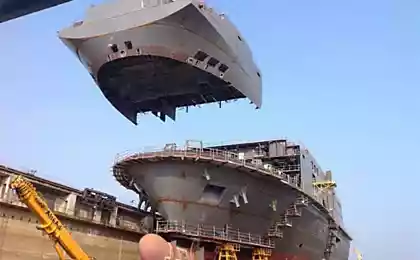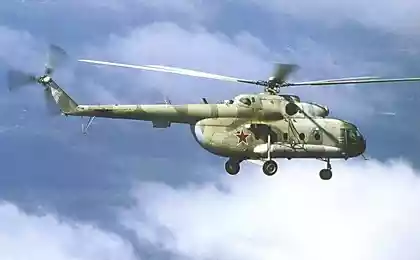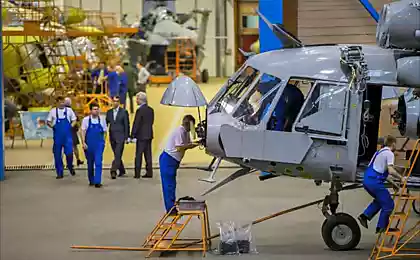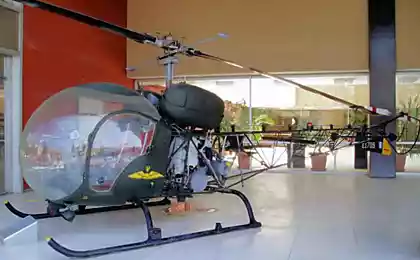1066
Attack helicopters Russian
Modern Russian attack helicopters - an overview of what we have in service. 14 ph and text.
Source: oko-planet.su/politik/politikarm/15...-vertolety.html
Photo 1: The Ka-52 is the initial batch in a standard set of standard equipment including defense - board №52 and №53 yellow board
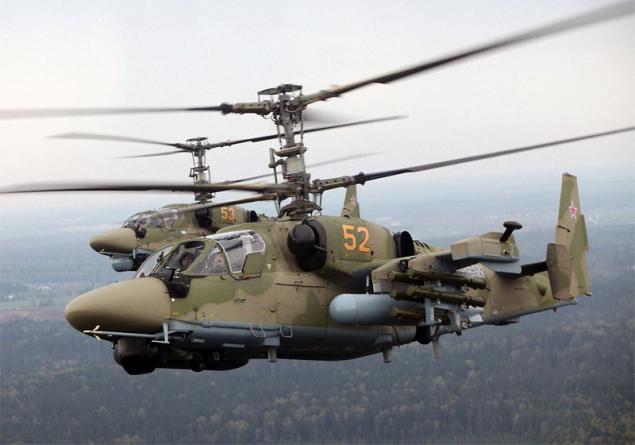
One of the most important points of the current State program is the re-supply of more than 1,100 helicopters. By 2020, the domestic defense industry needs to convey to the armed forces that is the number of rotary-wing technology. Already started to supply the troops and helicopters are seven models and modifications. By the end of the State program of models may increase in half to two times. Special attention is given to the procurement of new helicopters shock machines. Until recently, the task of supporting the troops and attack the enemy pinned only on the "old man" of the Mi-24 and its modifications. Now the Air Force immediately receive three types of combat helicopters, differing characteristics, equipment and strike capabilities. This Mi-35M (deep modernization of the Mi-24, also known as the Mi-24VM), Mi-28N and Ka-52. Just a few years ago it was possible to hope for the continued construction of the Ka-50, but as a result it has been discontinued in favor of a new and perfect Ka-52. Let's try to look closely at the available attack helicopters, compare and evaluate their opportunities. Unfortunately, part of the technical information on the newest helicopters until they became public, so you have to settle for just the available official data, even if incomplete.
Technical and performance characteristics
Considered machines vary considerably in the constructive aspect. Machinery company "Miles" performed by the classical scheme with a carrier and tail rotor. They are also equipped with the original X-obraznymy tail rotor having improved performance compared to the usual screws schemes. Ca-52, in turn, formed by the traditional "Kamova" diagram and has two coaxial rotors. Pros and cons of schemes used by more than one year are the subject of debate, but the designers and the military have made their choice: they understand the disadvantages of classical and pine schemes, but for the sake of the benefits available are ready to tolerate them. In addition, some interest is the fact that the main helicopters Russian Air Force in 2020 to become the "classic" Mi-28N and Ka-52 coaxial. Thus, there is, so to speak, the balance between the circuits.
Picture 2 Mi-28N board №50 yellow helicopters from the party, the BBC reported on an air base 344 TsBPiPLS AA October 8, 2011, g.Torzhok, Tver region
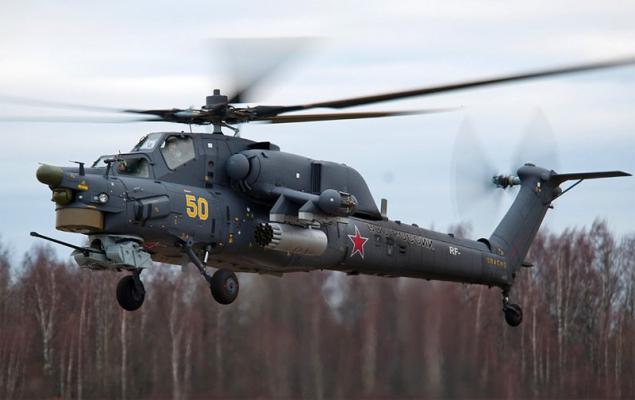
Picture 3 Mi-35M - the largest and most powerful
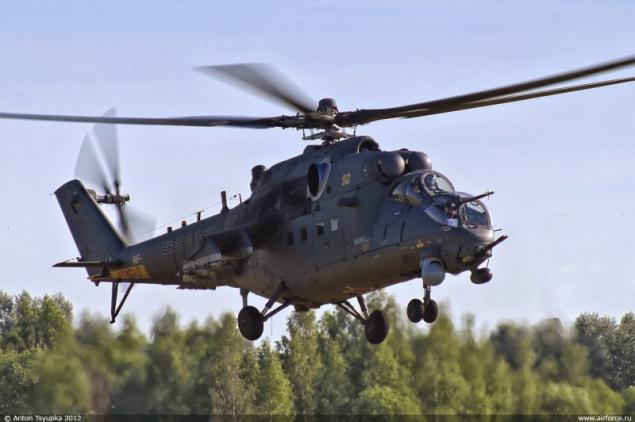
02Vse three helicopters significantly different at the level of mass and size parameters. The smallest among the machines under consideration is the Ka-52. At maximum takeoff weight to 10,400 kg it has a length of 13, 5 meters and a diameter of rotors 14, 5 m. Milevskyi Mi-28 is slightly larger than length of 17 meters, the diameter of the rotor 17 of 2 m and a maximum take-off weight of 11, 7 tons. The largest of the new helicopter is the Mi-35M, which has a maximum takeoff weight of 11,800 kg and a length of more than 18, 5 meters. It is noteworthy that both the helicopter company "Miles" feature the same main and tail rotor, which was originally developed for the Mi-28N.
An interesting way things are going with the power plant helicopter. All of them, in accordance with the trend of military helicopters, equipped with two engines. This reduces the risks of damage to one of the engines and, as a consequence, increases the lifetime of machines in combat conditions. In addition, all three helicopter turboshaft engines equipped family "Klimov" TV3-117VMA. Mi-35M has an engine of this model with the take-off power of 2,200 horsepower each, and Mi-28N and Ka-52 equipped with later modifications. Thus, the Mi-28N is equipped with motors VK-2500-02 (2,200 hp on takeoff), and Ka-52 is equipped with a VK-2500 engines with the possibility of "acceleration" of up to 2400 hp It should be noted that these power values can only be achieved over a short period of time. In flight, it is recommended to keep the engine power to not more than 1750-1800 horsepower. Moreover, all the engines are extremely family TV3-117VMA mode, which can reach the bar in 2600-2700 horsepower. However, these indicators of capacity requiring subsequent maintenance. Photo 4 Engine TV3-117

Photo 5 Engine VC-2500 (an upgraded version of TVZ-117)

03 is easy to see that the combination of weight and size and power parameters of the most interesting looks helicopter Ka-52. At the maximum permissible weight at takeoff engines it has the specific power to 460 hp ton weight. At Mi-35M and Mi-28N this option is approximately 370 and 375 hp per ton, respectively. Thus, the Kamov helicopter, having a large thrust-weight ratio, in theory, should have better performance characteristics. However, high power density are obtained, primarily due to the small mass of the structure and, as a consequence, a relatively small combat load. At the same time, a number of features of the concept led to the fact that more light Ka-52 is able to carry more weapons and equipment than the Mi-35H. The car firm "Kamov" has a payload of around two tonnes, while the Mi-35M, the figure is just 1,780 kg. As for the Mi-28N, it is able to carry on the external load of up to 2,300 kilograms of weapons.
The flight parameters of all three helicopters are sufficiently close, although they differ from each other. The maximum speed of all vehicles in the range 310-320 kilometers per hour. This Mi-35M and Ka-52 if necessary can accelerate up to 340 km / h, but the speed of the declared characteristics listed as the maximum allowable. More new Mi-28N and Ka-52 win over the deeply modernized Mi-24 in the dynamic and static ceiling. The first indicator of these machines is within 5-5, 5 thousand. Meters, the second - is 3600 m. Static and dynamic ceiling Mi-35M is less than these figures to 450-500 meters. Mi-35M can not boast and range. Its practical range is 420 kilometers, and the ferry to the configuration, it is able to overcome thousands of kilometers. For the Mi-28N, the figures are 500 and 1100 and for the Ka-52 - 520 and 1,200 kilometers, respectively.
04 It should be borne in mind that the maximum range, as well as the speed and the ceiling itself is not the most important parameter of the helicopter, but may indicate its capabilities concerning the length of stay in the air. The experience of the armed conflicts of recent years has shown that modern combat helicopter must, first of all, to be able to make long patrol a given area, regardless of the time of day and weather conditions. It was with the help of helicopters, NATO forces conducted a regular hunt for the enemy caravans or even individual fighters.
The crew and his defense
The concept of the use of attack helicopters is a high risk of being attacked air defense systems of the enemy. Because of this, all the cars in this class have a whole set of security crew. All three discussed the helicopter - the Mi-35M, Mi-28N and Ka-52 - has a crew of two. As a result of lengthy debate, it was recognized as the most profitable scheme with two pilots: pilot and weapons operator. Previously offered to impose all the responsibilities for one pilot, the customer the option in the face of the Ministry of Defense admitted bleak and uncomfortable. As a result, new domestic attack helicopters made double.
As in the case of the rotor machine firm "Kamov" differs from "Mi". The latter have a tandem cockpit schemes: pilot sitting behind and above the navigator-operator. In Ka-52 commander's workplace is located to the left of the axis of the machine operator's seat - right. All three machines operators weapons have the ability to control the helicopter, and the pilots can employ weapons. At the same time due to the separation of duties and corresponding equipment the pilot can not make full use of all the combat capability of the helicopter. To protect the crew and vital aggregates all three helicopters have additional armor: bulletproof glass and metal panels. The level of protection of various parts varies. For example, armor panels cockpit of the Mi-28N caliber projectile kept getting up to 20 millimeters.
Photo 6 Cab SC-52
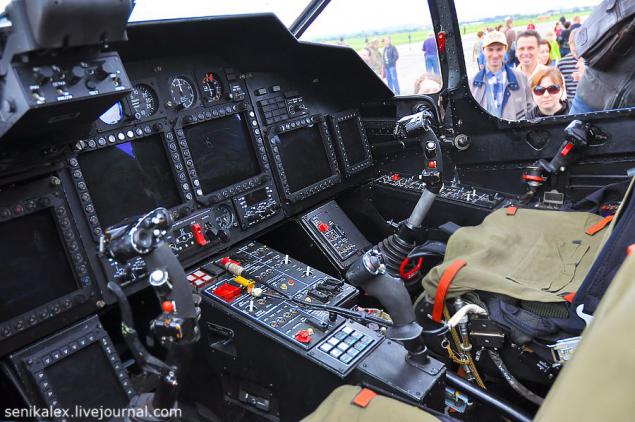
Photo 7 devices in the cockpit (left) and co-operator (right) of the Mi-28N
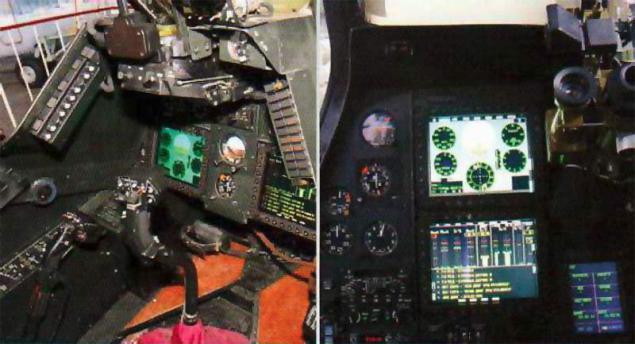
In the event of an emergency landing with a high vertical speed Mi-35M, Mi-28N and Ka-52 chassis has a special design, absorbing part of the force of impact on the ground. Most of the impact is absorbed by the remaining seats of special design. Moreover, Ka-52 and Mi-28N have a catapult system to rescue pilots in a crash at high altitudes.
Unguided weapons
For several decades the main armament of Russian attack helicopters were barreled system and rockets, and the use of "smart" munitions has been a much smaller scale. The new helicopter is fully preserved all the possibilities for the use of barrel and rocket weapons. Mi-35M, Mi-28N and Ka-52 have the opportunity to carry on the pylons under the wing blocks rockets of various types and calibers, from the C-8 (up to four blocks of 20 missiles) to C-13 (four of five). In addition, Mi-35M and Ka-52, if necessary, can apply up to four rockets C-24 caliber 240 mm. All three helicopters are able to use different types of aerial bombs caliber up to 500 kilograms.
In addition to the pylons for the suspension arms, all three machines have a built-in gun mount. The Ka-52 and Mi-28N is fitted with automatic cannon 2A42 (30 millimeters), Mi-35H - GS-23 (two-barrel caliber 23 mm). The movable gun mount mounted on Mi-28N and Mi-35M, helps to build weapons within significant sectors horizontally and vertically. The Ka-52 is, in turn, does not have such an opportunity: it is not gun mount in the fuselage nose, and on the right side, which greatly reduces the sector traverse. Both guns used in helicopters designed to destroy ground and air targets at ranges of up to two (GS-23) or four (2A42) kilometers. Pointing guns carried out by means of actuators controlled by the operator arms. It is noteworthy that the process of pointing guns affect the ability of pilots. For example, the pilot Mi-28N can operate a gun when it is not located on the longitudinal axis of the machine and is not in a horizontal position. Only with such an arrangement, the pilot can aim the cannon using the existing equipment of the impact it has. In all other cases, guidance and firing of weapons by the operator.
Photo 8 Ka-52 board №062 yellow, March 2012

Photo 9 ATGM "Attack-In" and block HAP B-13 under the Mi-28N board №38 on display MAKS-2011
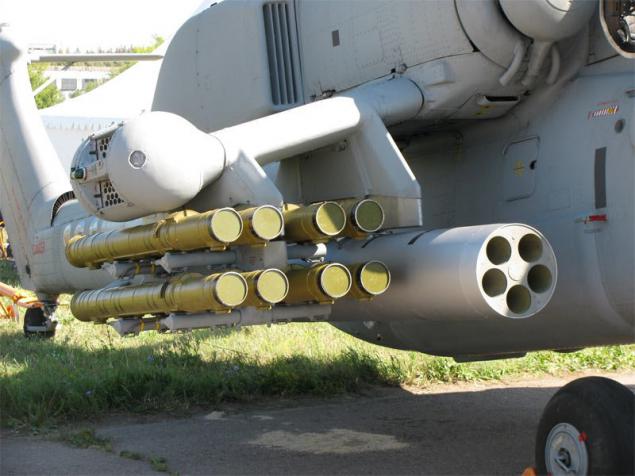
Photo 10 NAR Block B-13 and the launcher "Sagittarius" missile "Needle" by Mi-28N board №38 on display MAKS-2011
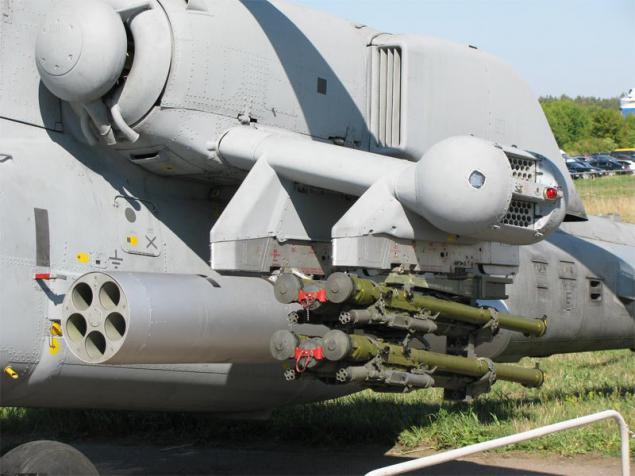
06 guided missile
The duties of navigator-operator is also included work with guided weapons. Traditionally, all domestic attack helicopters have the possibility of a anti-tank missiles, and Mi-35M, Mi-28N and Ka-52 is no exception. Covered car company "Miles" can carry up to 12-16 antitank guided missiles "Storm" or "attack". Arsenal Ka-52 is composed of missiles "Attack" or "vortex". These missile systems significantly different characteristics missiles and guidance systems.
The oldest complex "Sturm-V" (development of the 70s) has a radio command guidance system and provides maximum range at five kilometers. The missile 9M114 provides homogeneous armor penetration of up to 650 millimeters thick. The use of complex "Storm" semi-automatic control system led to the fact that the operator of arms after the start forced for some time to keep the reticle on the target. This fact has to some extent reduced the combat capabilities of the helicopter, as he is forced to remain motionless until the defeat of the purposes and will not be able to effectively use the tactic of jumping.
Further development of the "Sturm-V" has become a complex "attack-B" with a missile 9M120. The modernization has improved the characteristics of the missile. So, 9M120 capable of delivering a warhead to a distance of ten kilometers and punching up to 800 mm homogeneous armor for dynamic protection. There is evidence of the development of laser-homing missiles for the "Attack". The principle of missile guidance commands from a helicopter similar to "Storm". This feature of the complex "attack-B" is a cause for criticism. It should be noted that at a speed of about 500 m / s 9M120 missile reaches target at maximum range of about 20 seconds. To reduce the risk of the helicopter during the "jump" onboard equipment control "attack" makes it possible to maneuver with some limitations on the roll and pitch.
Antitank missile complex "Whirlwind" with a missile 9A4172 has a laser guidance system and automatic control equipment. Last independently produces target tracking and missile guidance to it. The maximum launch range missile complex "Whirlwind" is ten kilometers. With speeds in excess of 600 meters per second rocket overcomes distance of 15-17 seconds. Thus, enemy air defenses may simply not have enough time to detect and attack helicopter. In addition, automatic target tracking and missile guidance can significantly reduce the load on the pilots. This system was one of the reasons for the decline of the crew of the helicopter Ka-50 to a single person. Tandem warhead punches a meter homogeneous armor.
Despite his shock purpose, Mi-35M, Mi-28N and Ka-52 are able to carry guided missiles "Air-air" intended for self-defense. It missiles "Igla-V" (range up to 5-6 km) and P-60 (7-8 km). The number of missiles in the suspension depends on the tactical necessity and model helicopter. Thus, Mi-35M carries only two missiles of "Igla-V" and Mi-28N and Ka-52 - up to four "Eagle" or R-60.
Photo 11 The first prototype of the Ka-52 board №061 yellow on trial operation of the helicopter from the Navy ships, the Northern Fleet, 03.09.2011 of
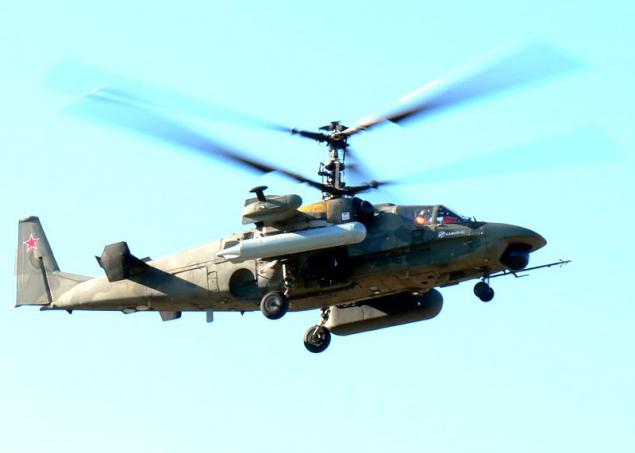
Photo 12 Mi-28N board №36 yellow, probably with an updated radar nadvtulochnoy.
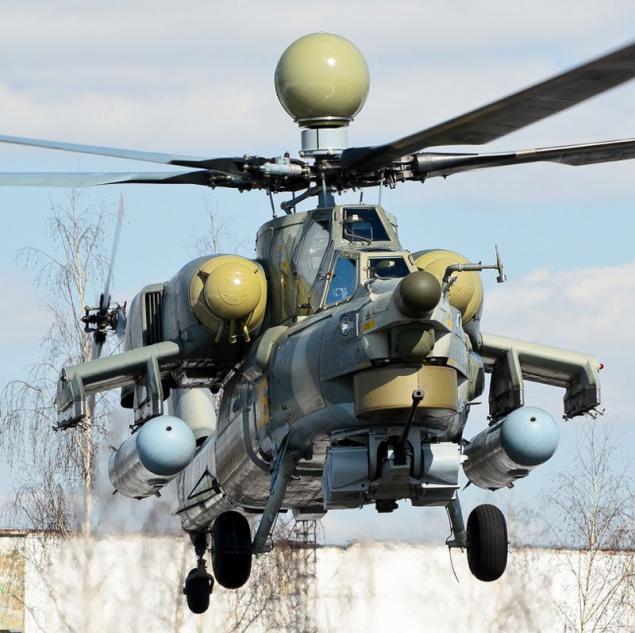
07Bortovoe equipment
As the old deep modernization of the Mi-24, Mi-35M has received relatively few major innovations in the composition of avionics affecting certain features of appearance. One of them concerns the installation of a new sighting and navigation complex PNK-24 created using the developments of the project PrNK-28 helicopter Mi-28N. It was updated optoelectronic station, observation instruments and equipment cabin. As a result of the combat potential of helicopters significantly increased. It is sometimes argued that at the moment avionics of the Mi-35M helicopter provides the highest possible specifications, which allows for a rather old design.
The basis of the avionics of the Mi-28N is a complex PrNK-28, ensure the implementation of safety and combat work. This complex integrated weapons control system and navigation equipment. Furthermore, PrNK-28 is associated with radar H-025. Its antenna is located in the characteristic spherical fairing over the hub. Using radar greatly enhances the helicopter, for example, allows you to fly and carry out attacks in any weather and at any time. Radar N-025 has two basic modes of operation: Air and ground targets. In the case of ground radar tracking "View" sector width of 120 degrees at a distance of 32 kilometers. In this mode, the H-025 is capable card is about the underlying surface. Detection and tracking of targets, depending on their EPR occurs at distances of 12-15 kilometers (tank). Larger objects, such as bridges, station notices from 23-25 km. In operation, the air antenna station scans all the surrounding space sector in a width of 60 degrees in the vertical plane. Aircraft in this case, the "visible" at a distance of 15 kilometers. Anti-aircraft missiles and ammunition "air-air" - with five or six kilometers. Thus, pilots are able to promptly learn about the attack and do all the necessary actions.
The onboard equipment Ka-52 is to some extent similar to the use of Mi-28N, but has some differences.
Source:
Source: oko-planet.su/politik/politikarm/15...-vertolety.html
Photo 1: The Ka-52 is the initial batch in a standard set of standard equipment including defense - board №52 and №53 yellow board

One of the most important points of the current State program is the re-supply of more than 1,100 helicopters. By 2020, the domestic defense industry needs to convey to the armed forces that is the number of rotary-wing technology. Already started to supply the troops and helicopters are seven models and modifications. By the end of the State program of models may increase in half to two times. Special attention is given to the procurement of new helicopters shock machines. Until recently, the task of supporting the troops and attack the enemy pinned only on the "old man" of the Mi-24 and its modifications. Now the Air Force immediately receive three types of combat helicopters, differing characteristics, equipment and strike capabilities. This Mi-35M (deep modernization of the Mi-24, also known as the Mi-24VM), Mi-28N and Ka-52. Just a few years ago it was possible to hope for the continued construction of the Ka-50, but as a result it has been discontinued in favor of a new and perfect Ka-52. Let's try to look closely at the available attack helicopters, compare and evaluate their opportunities. Unfortunately, part of the technical information on the newest helicopters until they became public, so you have to settle for just the available official data, even if incomplete.
Technical and performance characteristics
Considered machines vary considerably in the constructive aspect. Machinery company "Miles" performed by the classical scheme with a carrier and tail rotor. They are also equipped with the original X-obraznymy tail rotor having improved performance compared to the usual screws schemes. Ca-52, in turn, formed by the traditional "Kamova" diagram and has two coaxial rotors. Pros and cons of schemes used by more than one year are the subject of debate, but the designers and the military have made their choice: they understand the disadvantages of classical and pine schemes, but for the sake of the benefits available are ready to tolerate them. In addition, some interest is the fact that the main helicopters Russian Air Force in 2020 to become the "classic" Mi-28N and Ka-52 coaxial. Thus, there is, so to speak, the balance between the circuits.
Picture 2 Mi-28N board №50 yellow helicopters from the party, the BBC reported on an air base 344 TsBPiPLS AA October 8, 2011, g.Torzhok, Tver region

Picture 3 Mi-35M - the largest and most powerful

02Vse three helicopters significantly different at the level of mass and size parameters. The smallest among the machines under consideration is the Ka-52. At maximum takeoff weight to 10,400 kg it has a length of 13, 5 meters and a diameter of rotors 14, 5 m. Milevskyi Mi-28 is slightly larger than length of 17 meters, the diameter of the rotor 17 of 2 m and a maximum take-off weight of 11, 7 tons. The largest of the new helicopter is the Mi-35M, which has a maximum takeoff weight of 11,800 kg and a length of more than 18, 5 meters. It is noteworthy that both the helicopter company "Miles" feature the same main and tail rotor, which was originally developed for the Mi-28N.
An interesting way things are going with the power plant helicopter. All of them, in accordance with the trend of military helicopters, equipped with two engines. This reduces the risks of damage to one of the engines and, as a consequence, increases the lifetime of machines in combat conditions. In addition, all three helicopter turboshaft engines equipped family "Klimov" TV3-117VMA. Mi-35M has an engine of this model with the take-off power of 2,200 horsepower each, and Mi-28N and Ka-52 equipped with later modifications. Thus, the Mi-28N is equipped with motors VK-2500-02 (2,200 hp on takeoff), and Ka-52 is equipped with a VK-2500 engines with the possibility of "acceleration" of up to 2400 hp It should be noted that these power values can only be achieved over a short period of time. In flight, it is recommended to keep the engine power to not more than 1750-1800 horsepower. Moreover, all the engines are extremely family TV3-117VMA mode, which can reach the bar in 2600-2700 horsepower. However, these indicators of capacity requiring subsequent maintenance. Photo 4 Engine TV3-117

Photo 5 Engine VC-2500 (an upgraded version of TVZ-117)

03 is easy to see that the combination of weight and size and power parameters of the most interesting looks helicopter Ka-52. At the maximum permissible weight at takeoff engines it has the specific power to 460 hp ton weight. At Mi-35M and Mi-28N this option is approximately 370 and 375 hp per ton, respectively. Thus, the Kamov helicopter, having a large thrust-weight ratio, in theory, should have better performance characteristics. However, high power density are obtained, primarily due to the small mass of the structure and, as a consequence, a relatively small combat load. At the same time, a number of features of the concept led to the fact that more light Ka-52 is able to carry more weapons and equipment than the Mi-35H. The car firm "Kamov" has a payload of around two tonnes, while the Mi-35M, the figure is just 1,780 kg. As for the Mi-28N, it is able to carry on the external load of up to 2,300 kilograms of weapons.
The flight parameters of all three helicopters are sufficiently close, although they differ from each other. The maximum speed of all vehicles in the range 310-320 kilometers per hour. This Mi-35M and Ka-52 if necessary can accelerate up to 340 km / h, but the speed of the declared characteristics listed as the maximum allowable. More new Mi-28N and Ka-52 win over the deeply modernized Mi-24 in the dynamic and static ceiling. The first indicator of these machines is within 5-5, 5 thousand. Meters, the second - is 3600 m. Static and dynamic ceiling Mi-35M is less than these figures to 450-500 meters. Mi-35M can not boast and range. Its practical range is 420 kilometers, and the ferry to the configuration, it is able to overcome thousands of kilometers. For the Mi-28N, the figures are 500 and 1100 and for the Ka-52 - 520 and 1,200 kilometers, respectively.
04 It should be borne in mind that the maximum range, as well as the speed and the ceiling itself is not the most important parameter of the helicopter, but may indicate its capabilities concerning the length of stay in the air. The experience of the armed conflicts of recent years has shown that modern combat helicopter must, first of all, to be able to make long patrol a given area, regardless of the time of day and weather conditions. It was with the help of helicopters, NATO forces conducted a regular hunt for the enemy caravans or even individual fighters.
The crew and his defense
The concept of the use of attack helicopters is a high risk of being attacked air defense systems of the enemy. Because of this, all the cars in this class have a whole set of security crew. All three discussed the helicopter - the Mi-35M, Mi-28N and Ka-52 - has a crew of two. As a result of lengthy debate, it was recognized as the most profitable scheme with two pilots: pilot and weapons operator. Previously offered to impose all the responsibilities for one pilot, the customer the option in the face of the Ministry of Defense admitted bleak and uncomfortable. As a result, new domestic attack helicopters made double.
As in the case of the rotor machine firm "Kamov" differs from "Mi". The latter have a tandem cockpit schemes: pilot sitting behind and above the navigator-operator. In Ka-52 commander's workplace is located to the left of the axis of the machine operator's seat - right. All three machines operators weapons have the ability to control the helicopter, and the pilots can employ weapons. At the same time due to the separation of duties and corresponding equipment the pilot can not make full use of all the combat capability of the helicopter. To protect the crew and vital aggregates all three helicopters have additional armor: bulletproof glass and metal panels. The level of protection of various parts varies. For example, armor panels cockpit of the Mi-28N caliber projectile kept getting up to 20 millimeters.
Photo 6 Cab SC-52

Photo 7 devices in the cockpit (left) and co-operator (right) of the Mi-28N

In the event of an emergency landing with a high vertical speed Mi-35M, Mi-28N and Ka-52 chassis has a special design, absorbing part of the force of impact on the ground. Most of the impact is absorbed by the remaining seats of special design. Moreover, Ka-52 and Mi-28N have a catapult system to rescue pilots in a crash at high altitudes.
Unguided weapons
For several decades the main armament of Russian attack helicopters were barreled system and rockets, and the use of "smart" munitions has been a much smaller scale. The new helicopter is fully preserved all the possibilities for the use of barrel and rocket weapons. Mi-35M, Mi-28N and Ka-52 have the opportunity to carry on the pylons under the wing blocks rockets of various types and calibers, from the C-8 (up to four blocks of 20 missiles) to C-13 (four of five). In addition, Mi-35M and Ka-52, if necessary, can apply up to four rockets C-24 caliber 240 mm. All three helicopters are able to use different types of aerial bombs caliber up to 500 kilograms.
In addition to the pylons for the suspension arms, all three machines have a built-in gun mount. The Ka-52 and Mi-28N is fitted with automatic cannon 2A42 (30 millimeters), Mi-35H - GS-23 (two-barrel caliber 23 mm). The movable gun mount mounted on Mi-28N and Mi-35M, helps to build weapons within significant sectors horizontally and vertically. The Ka-52 is, in turn, does not have such an opportunity: it is not gun mount in the fuselage nose, and on the right side, which greatly reduces the sector traverse. Both guns used in helicopters designed to destroy ground and air targets at ranges of up to two (GS-23) or four (2A42) kilometers. Pointing guns carried out by means of actuators controlled by the operator arms. It is noteworthy that the process of pointing guns affect the ability of pilots. For example, the pilot Mi-28N can operate a gun when it is not located on the longitudinal axis of the machine and is not in a horizontal position. Only with such an arrangement, the pilot can aim the cannon using the existing equipment of the impact it has. In all other cases, guidance and firing of weapons by the operator.
Photo 8 Ka-52 board №062 yellow, March 2012

Photo 9 ATGM "Attack-In" and block HAP B-13 under the Mi-28N board №38 on display MAKS-2011

Photo 10 NAR Block B-13 and the launcher "Sagittarius" missile "Needle" by Mi-28N board №38 on display MAKS-2011

06 guided missile
The duties of navigator-operator is also included work with guided weapons. Traditionally, all domestic attack helicopters have the possibility of a anti-tank missiles, and Mi-35M, Mi-28N and Ka-52 is no exception. Covered car company "Miles" can carry up to 12-16 antitank guided missiles "Storm" or "attack". Arsenal Ka-52 is composed of missiles "Attack" or "vortex". These missile systems significantly different characteristics missiles and guidance systems.
The oldest complex "Sturm-V" (development of the 70s) has a radio command guidance system and provides maximum range at five kilometers. The missile 9M114 provides homogeneous armor penetration of up to 650 millimeters thick. The use of complex "Storm" semi-automatic control system led to the fact that the operator of arms after the start forced for some time to keep the reticle on the target. This fact has to some extent reduced the combat capabilities of the helicopter, as he is forced to remain motionless until the defeat of the purposes and will not be able to effectively use the tactic of jumping.
Further development of the "Sturm-V" has become a complex "attack-B" with a missile 9M120. The modernization has improved the characteristics of the missile. So, 9M120 capable of delivering a warhead to a distance of ten kilometers and punching up to 800 mm homogeneous armor for dynamic protection. There is evidence of the development of laser-homing missiles for the "Attack". The principle of missile guidance commands from a helicopter similar to "Storm". This feature of the complex "attack-B" is a cause for criticism. It should be noted that at a speed of about 500 m / s 9M120 missile reaches target at maximum range of about 20 seconds. To reduce the risk of the helicopter during the "jump" onboard equipment control "attack" makes it possible to maneuver with some limitations on the roll and pitch.
Antitank missile complex "Whirlwind" with a missile 9A4172 has a laser guidance system and automatic control equipment. Last independently produces target tracking and missile guidance to it. The maximum launch range missile complex "Whirlwind" is ten kilometers. With speeds in excess of 600 meters per second rocket overcomes distance of 15-17 seconds. Thus, enemy air defenses may simply not have enough time to detect and attack helicopter. In addition, automatic target tracking and missile guidance can significantly reduce the load on the pilots. This system was one of the reasons for the decline of the crew of the helicopter Ka-50 to a single person. Tandem warhead punches a meter homogeneous armor.
Despite his shock purpose, Mi-35M, Mi-28N and Ka-52 are able to carry guided missiles "Air-air" intended for self-defense. It missiles "Igla-V" (range up to 5-6 km) and P-60 (7-8 km). The number of missiles in the suspension depends on the tactical necessity and model helicopter. Thus, Mi-35M carries only two missiles of "Igla-V" and Mi-28N and Ka-52 - up to four "Eagle" or R-60.
Photo 11 The first prototype of the Ka-52 board №061 yellow on trial operation of the helicopter from the Navy ships, the Northern Fleet, 03.09.2011 of

Photo 12 Mi-28N board №36 yellow, probably with an updated radar nadvtulochnoy.

07Bortovoe equipment
As the old deep modernization of the Mi-24, Mi-35M has received relatively few major innovations in the composition of avionics affecting certain features of appearance. One of them concerns the installation of a new sighting and navigation complex PNK-24 created using the developments of the project PrNK-28 helicopter Mi-28N. It was updated optoelectronic station, observation instruments and equipment cabin. As a result of the combat potential of helicopters significantly increased. It is sometimes argued that at the moment avionics of the Mi-35M helicopter provides the highest possible specifications, which allows for a rather old design.
The basis of the avionics of the Mi-28N is a complex PrNK-28, ensure the implementation of safety and combat work. This complex integrated weapons control system and navigation equipment. Furthermore, PrNK-28 is associated with radar H-025. Its antenna is located in the characteristic spherical fairing over the hub. Using radar greatly enhances the helicopter, for example, allows you to fly and carry out attacks in any weather and at any time. Radar N-025 has two basic modes of operation: Air and ground targets. In the case of ground radar tracking "View" sector width of 120 degrees at a distance of 32 kilometers. In this mode, the H-025 is capable card is about the underlying surface. Detection and tracking of targets, depending on their EPR occurs at distances of 12-15 kilometers (tank). Larger objects, such as bridges, station notices from 23-25 km. In operation, the air antenna station scans all the surrounding space sector in a width of 60 degrees in the vertical plane. Aircraft in this case, the "visible" at a distance of 15 kilometers. Anti-aircraft missiles and ammunition "air-air" - with five or six kilometers. Thus, pilots are able to promptly learn about the attack and do all the necessary actions.
The onboard equipment Ka-52 is to some extent similar to the use of Mi-28N, but has some differences.
Source:





